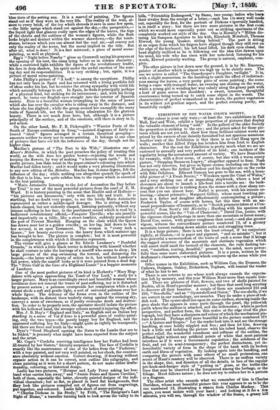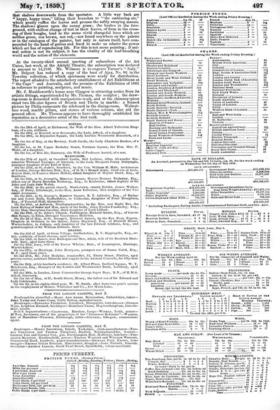EXHIBITION OF THE WATER COLOUR SOCIETY. EXHIBITION OF THE WATER
COLOUR SOCIETY.
Water colour is your only ware ;—at least the two exhibitions in Pall Mall, East and West, exhibit a large proportion of pictures that display the valuable element of being " sold. In the gallery of the older Society the proportion is striking to the eye ; and the prices asked for those pic- tures which are not yet sold, show how these brilliant cabinet works are prized by the owners of our daintily furnished but not spacious mansions. Another trait of the Exhibition is that there is no Carl Haag upon its walls ; another that Alfred Fripp has betaken him from Irish to English characters. For the rest the Exhibition is pretty much what we are ac- customed to annually and very perfect of its kind; one incident of the regularity being the accustomed amount of variety. We have Branwhite for example, with a frost scene, of course, but also with a warm sunny picture, " Stepping Stones on Lugwy," altogether opposed to frost. Nash has not only interiors, but gives us figure scenes, including one from the Antiquary, where Sir Arthur Wardour and his daughter are on the rocks with Edie Ochiltree. Edward Duncan has gone to the sea, with a beau- tiful picture of "A Fresh Breeze," " Wreckers upon the Coast of Wales," and a very striking one of an impending shipwreck, where a host of shoremen are about to launch a life-boat into a terrific sea : the back- draught of the breaker is rushing down the stones with a clear sharp tor- rent that you can almost hear. Naftel is present, with his intense co- louring,—almost prismatic; Margaret Gillies, whose most touching pic- ture is a father and daughter affectionately contemplating a picture ; Frederick Tayler, of course with horses, but this time with an un- usual preponderance of humanity, as in " kat& prisoners taken at a Con- venticle," from Scott's Old Mortality; Harding with his spacious and powerful scenes, like the "Vale of Chamouni ; " Ditvid Cox, junior, with the vigorous cloud-gatherings in more than one mountain or forest scene; David Cox, senior, with greater roughness than usual,—and also greater vigour witness the extraordinary picture numbered 73, of a gloomy mountain torrent rushing down amidst rocks and struggling trees. It is a large picture; there is not the least attempt, if we conjecture rightly, at illusion,—it is paper and pigment, " and no mistake"; but it is so powerful a memorandum of the traits of such a scene that it brings the rugged structure of the mountain and obstinate vegetation which will assert itself amid the turmoil of the elements, the rude dashing tor- rent, "resistless, roaring, dreadful," present to the mind, more power- fully than some more elaborated pictures. It is a poem, written in the draftsman's characters,—a writing which conjures up the scene while you read it.
Other names in the Exhibition, such as William Cox, the Evanses, the Callows, Dodgson, Oakley, Richardson, Topham, will remind the reader of what he has to see.
There is one veteran to see whose work always exceeds the expecta- tion left by memory, and this year William Hunt more than equals him- self. There are pictures of fruit, flowers, and two of shells painted for Ruskin, all in Hunt's peculiar manner; but three that need long scrutiny fa discover all their beauties. A couple of them are numbered 225 and 226, " Sea-shells," and an " Oystershell and Onion." The sea-shells, if we are correct in our conchology, are muscles. They lie under a piece of red- dish rock. The oyster-shell lies upon its outer surface, showing inside the grey shade that appears in some parts through the pearl, the yellowish patch where the mollusc is attached, and the iridescence ; while in perfect perspective, and perfect form, the thin scales at the edge rival the pho- tograph, but they have a sharpness and colour of which the mechanical pic- ture is devoid. Perhaps still more beautiful is the picture numbered 271 —" A Quince and Grapes." Let the reader look into it and see the strange handling, at once boldly stippled and free; and then let him, drawing back a little and isolating the picture with his tubed hand, observe the perfect relief, the wonderful roundness and softness of the outline, the diffused light without any artificial points of white that most painters introduce as if it were a Government regulation ; the solidness of the fruit, and yet its semi-transparency;' the perfect distinctness, yet in- describable' variety of form in the shape of the bank with its broken earth and fibres of vegetation. By looking again into the handling, and comparing the picture with some others of no small pretensions, one secret of Hunt's mastery will be observed. There is an endless variety in the shape, tint, and direction of all the details, in lieu of the regular pot-hook-and-hanger style of "putting in" grass, or the trellis-like lines that may be observed in the foreground among the herbage, or the foliage. Hunt follows nature ; he does not try to reduce her to a pattern or a diagram. The other artist who exceeds what we remember of him is Charles Davidson, whose most beautiful picture this year appears to us to be the one numbered 13, illustrating a stanza from Charles Mackay. This again, you must isolate with your hand ; and looking at it for a few minutes, you will see, through the window of the frame, a grassy hill
that shelves downwards from the spectator. A little way back are " happy, happy trees," lifting their branches to " the embracing air," which gently ruffles the leaves and presses the softly swaying masses. The shadows glance upon the sunny grass ; the bushes in the fore- ground, with endless change of tint in their leaves, of form in the cross- ing of their boughs, lend to the scene vivid changeful hues which are neither green, nor brown, nor red,-nor found anywhere on the palette or in the catalogue of the painter, but only in nature itself, here com- pounded by the hand of genius and fixed to make us admire the power which art has of reproducing life. For this is not scene painting ; if ani- mal action is not its subject, it has the vitality of the leaf-breathing world and the action of the elements.



























 Previous page
Previous page